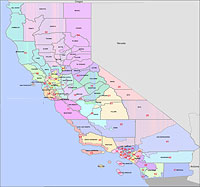Redistricting Reform
Redistricting is typically an intensely political process, as the determinatiqon for where a political district line falls can benefit or harm an incumbent politician or a would-be candidate for public office. By Including or excluding certain communities from a political district, the decision-makers who draw political district maps can increase the likelihood that favored candidates or parties are elected to office and leave those candidates or parties who are out of favor at a disadvantage. |
||
Prop. 11 implementation:
Political maps & resources:
Redistricting resources:
|
In November 2008, California voters approved Proposition 11, the "Voters First Act", an initiative constitutional amendment that shifts the power to redraw legislative and Board of Equalization political district lines from the California Legislature to a new 14-member Citizens Redistricting Commission. (Under the provisions of Prop. 11, the Legislature will continue to draw Congressional district lines). The new commission will begin its work in 2011. The passage of Prop. 11 was historic, marking the first time in California history when the power to draw political district lines was taken away from the Legislature and given to citizens. (Over the past 27 years, there have been four previous attempts to create independent redistricting commissions: Proposition 14 of 1982, Proposition 39 of 1984, Proposition 119 of 1990, and Proposition 77 of 2005; all failed.) Although CVF did not take a position on Proposition 11 (CVF does not endorse or oppose measures on the ballot), now that the measure has passed, CVF is working toward its successful implementation. Abuse in the redistricting process is a primary example of the irresponsible use of technology in the democratic process. For decades, California politicians have been using computers and elaborate demographic data to carve up California’s political districts in ways that suit the needs of the politicians in power. The result is political districts that divide up counties, neighborhoods and communities of interest, and as a result dilute the effectiveness of numerous groups of voters across the state. An independent redistricting commission represents an unprecedented opportunity to shape a new redistricting process, one that puts the needs of voters above the interests of politicians. Having political district lines drawn so that communities of interest are respected and protected will enable groups of constituents who share common concerns by virtue of where they live to have a more powerful voice in the political process. Although the citizens redistricting commission’s work will not begin until 2011, much must happen between now and then to ensure the commission is formed on schedule and new district lines are drawn on a timely basis to coincide with the decennial reapportionment. The resources on this page are designed to help facilitate successful implementation of Proposition 11. |
|
Site Map |
Privacy Policy | About
Calvoter.org
This page was first published on April
16, 2009 |
Last updated on
December 6, 2011
Copyright California Voter Foundation, All Rights Reserved.


